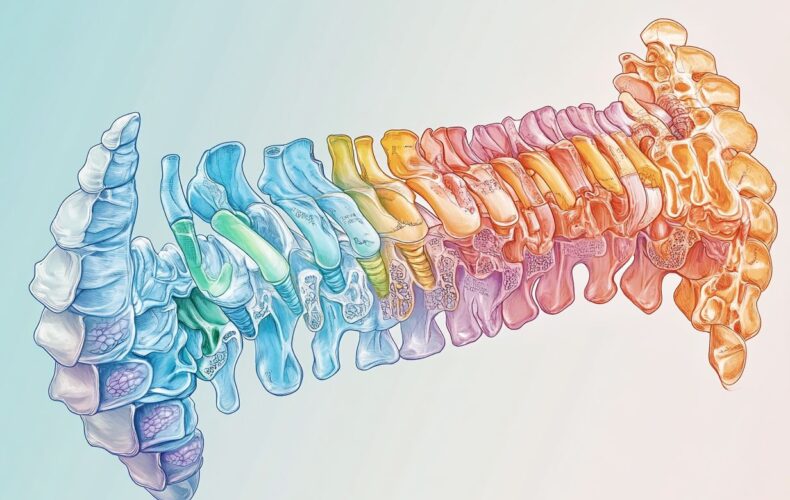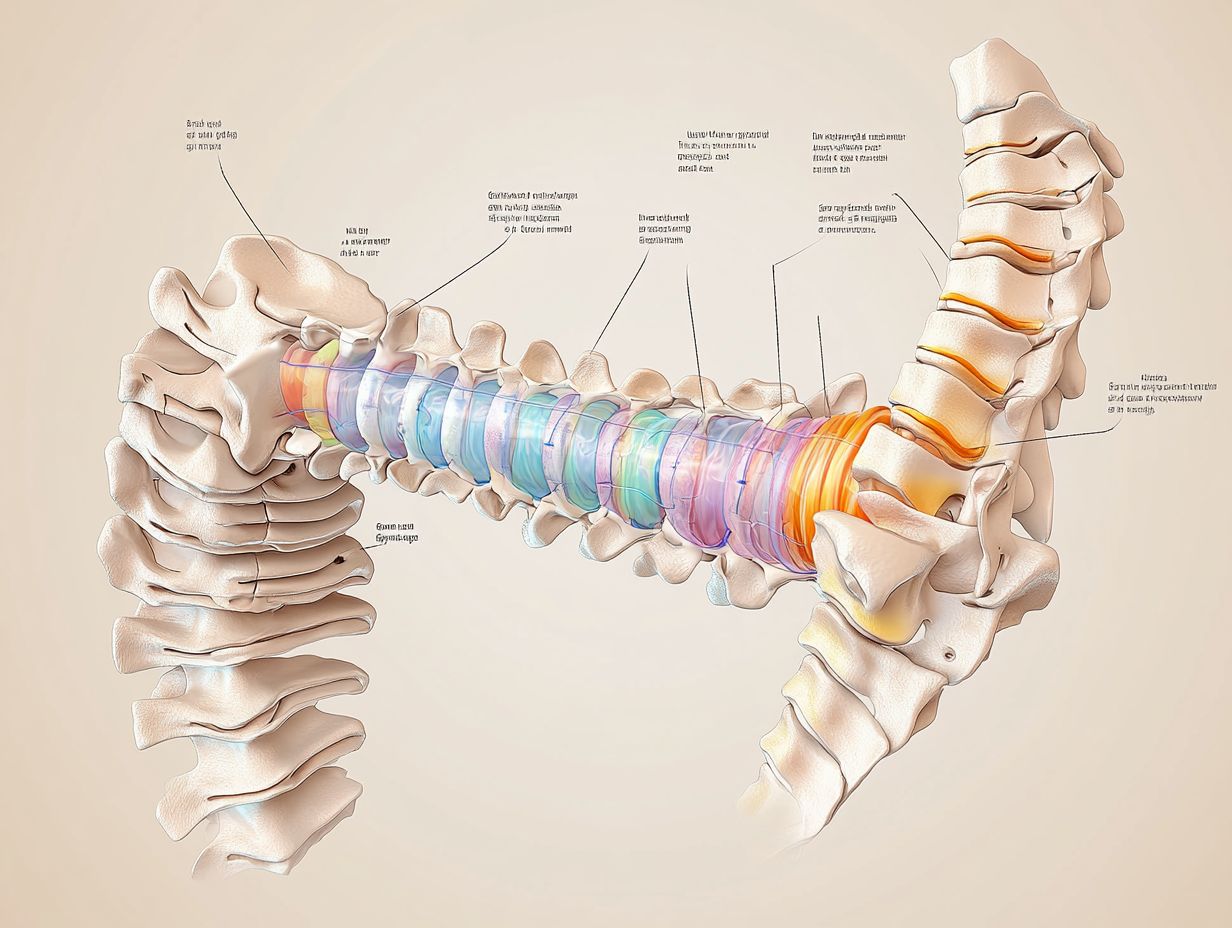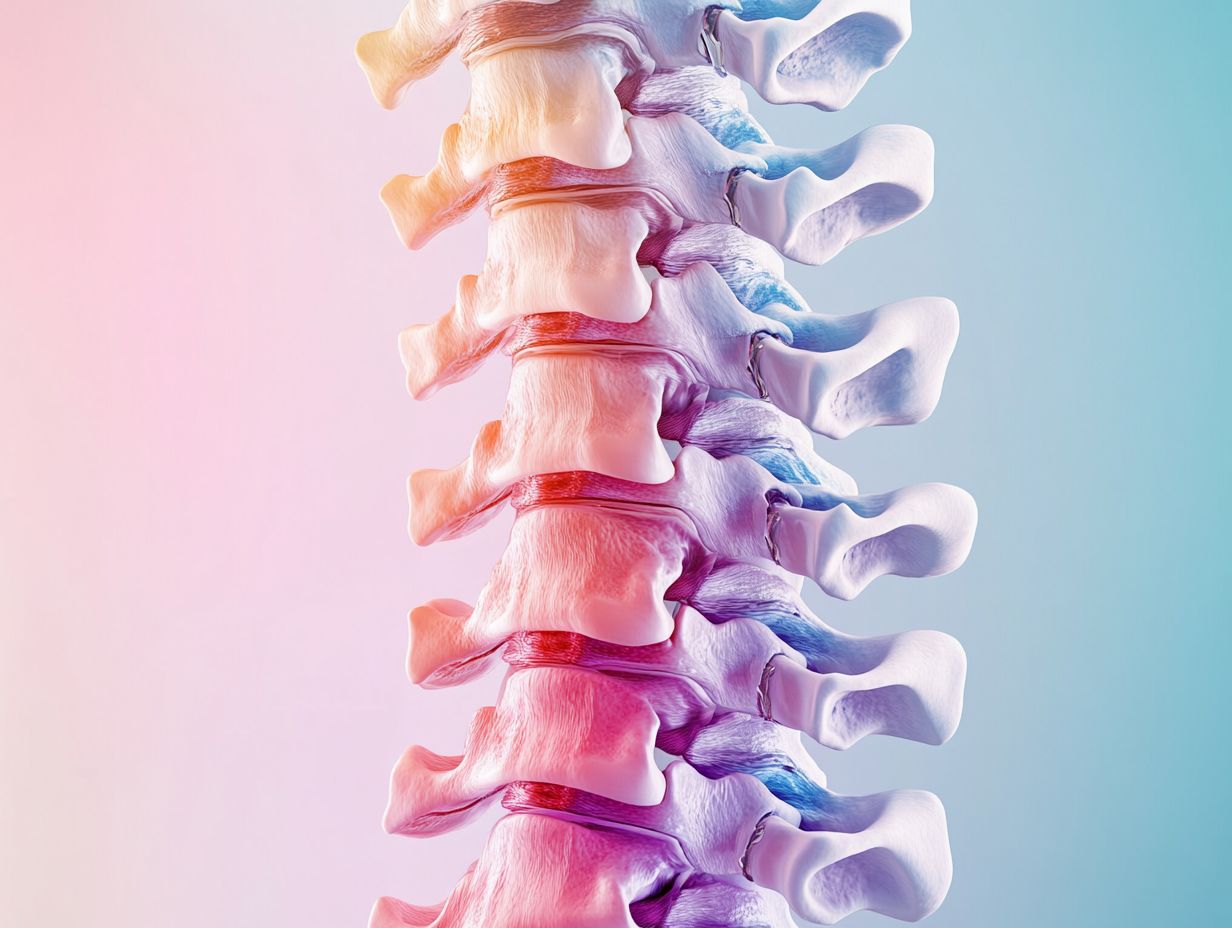The Connection Between Spine Health and Overall Wellness
The spine is often referred to as the body’s backbone—both literally and figuratively. Beyond its structural role, the health of our spine is intricately linked to our overall wellness, influencing everything from physical mobility to mental clarity.
This discussion explores how maintaining a healthy spine can enhance your quality of life, examining its impact on physical health, emotional well-being, and daily productivity.
We will cover the factors that affect spine health and offer practical strategies for keeping your spine—and your wellness—strong.
Understanding the Importance of Spine Health

Recognizing the significance of spine health is essential for preserving not only physical functionality but also mental and emotional well-being.
A healthy spine facilitates mobility and flexibility while helping to prevent chronic pain.
Role of the Spine in the Body
The spine serves as the fundamental framework of the human body, providing essential structural support while encasing the spinal cord, which transmits neural signals between the brain and various body parts.
This complex structure is organized into several distinct regions, including the cervical, thoracic, lumbar, sacral, and coccygeal areas, each fulfilling specific functions. The cervical spine, composed of seven vertebrae, is instrumental in supporting the head and facilitating a wide range of neck movements, thereby contributing to proper balance and coordination. In contrast, the lumbar region, consisting of five vertebrae, supports a significant portion of the body’s weight and is essential for movements such as bending and lifting.
Spinal nerves that emerge from these regions are critical for transmitting sensory information from the body to the brain, allowing individuals to respond effectively to their environment. These nerves relay messages concerning touch, pain, and temperature, ensuring effective communication between the central nervous system and peripheral bodily functions.
How Spine Health Affects Overall Wellness
Spine health plays a critical role in overall wellness, as it influences physical capabilities, chronic pain levels, and even mental health. Spinal misalignment can lead to debilitating conditions that significantly impact daily life.
When an individual encounters issues with spinal alignment or health, mobility may be restricted, making simple tasks such as bending, lifting, or walking feel extraordinarily challenging. This reduction in flexibility often creates a cycle of physical inactivity, which can exacerbate feelings of frustration and hopelessness. Chronic pain associated with poor spinal health not only diminishes quality of life by limiting movement but can also contribute to increased stress and anxiety levels.
As the body grapples with pain, maintaining a positive mental state becomes increasingly difficult, further complicating the interplay between physical and psychological wellbeing. Thus, prioritizing spine health is essential for fostering a harmonious balance across all facets of wellness.
Main Areas Affected by Spine Health
Several key areas are significantly influenced by spine health, including physical health, mental well-being, emotional stability, and overall productivity in daily activities.
Therefore, it is imperative to prioritize the maintenance of a healthy spine.
Physical Health and Mobility

Physical health and mobility are intrinsically connected to spine health. A well-aligned spine provides essential support for core muscles and facilitates unrestricted body movements, thereby reducing the risk of chronic pain.
Regular physical activity is critical for maintaining spinal alignment, as it enhances flexibility and strengthens the muscles surrounding the spine. Activities such as yoga, swimming, and resistance training not only improve mobility but also promote proper posture, which is particularly important for individuals aiming to alleviate chronic pain.
Understanding proper lifting techniques is imperative; utilizing correct movements when handling heavy objects can prevent unnecessary stress on the spine, thereby preserving its structural integrity.
Ultimately, individuals who prioritize their spine health through consistent exercise and appropriate body mechanics can experience a substantial enhancement in their overall quality of life.
Mental Health and Emotional Well-being
The relationship between spinal health and mental health is frequently underestimated; chronic pain resulting from spinal disorders can significantly impact emotional well-being and overall health.
When individuals endure persistent pain due to spinal conditions, it often initiates a cycle of anxiety and depression, underscoring the intricate connection between mental state and physical health. This ongoing discomfort can hinder daily activities, leading to social withdrawal and a diminished quality of life. The psychological burden of managing chronic pain can intensify feelings of helplessness and frustration.
Consequently, prioritizing and maintaining spinal health is essential not only for physical functionality but also for promoting emotional resilience. This underscores the necessity for comprehensive approaches that simultaneously address both physical and mental health to achieve true holistic well-being.
Impacts on Productivity and Daily Activities
Poor spine health can significantly affect productivity and daily activities, as chronic pain and spinal misalignment can impede an individual’s ability to perform tasks effectively. This disruption often results in decreased focus, increased fatigue, and a pervasive sense of discomfort that can render even simple tasks overwhelming.
For many individuals, the difficulty in maintaining concentration amid persistent pain can lead to missed deadlines and reduced output. Inadequate spine support can exacerbate the body’s alignment issues, creating a detrimental cycle of pain and diminished performance.
Utilizing ergonomic furniture and emphasizing proper posture are essential strategies in addressing these challenges. These measures help alleviate strain and promote healthier spinal alignment, ultimately enhancing comfort and efficiency in both professional and personal contexts.
Factors Influencing Spine Health
Various factors significantly impact spinal health, including ergonomic practices in daily activities, the frequency and type of physical exercise, nutritional intake, the quality of sleep, and lifestyle choices such as smoking and the importance of proper hydration.
Ergonomics in Daily Life

Ergonomics plays a vital role in maintaining spinal health, as proper posture and the utilization of ergonomic furniture can significantly enhance spinal stability and prevent discomfort.
It is essential for individuals who spend prolonged periods seated or engaged in repetitive tasks to understand how these principles apply in various settings. Whether working at a desk in an office or relaxing on a couch at home, individuals can benefit from thoughtfully arranging their environments to promote healthy alignment.
This involves selecting chairs that support the natural curvature of the spine, ensuring that computer screens are positioned at eye level, and using footrests to maintain feet flat on the ground.
By implementing these ergonomic solutions, not only is comfort improved, but overall productivity and well-being can also experience a significant enhancement.
The Importance of Exercise and Movement
Regular exercise and movement are essential for maintaining spinal health, as they strengthen core muscles and enhance overall physical activity, thereby providing improved support for the spine.
Incorporating specific therapeutic exercises, such as Pilates and yoga, significantly contributes to the flexibility and strength of the muscles surrounding the spine. Stretching routines, particularly those that focus on the lower back and hamstrings, play a critical role in alleviating tension and enhancing mobility.
Maintaining a consistent level of physical activity not only aids in the prevention of spinal issues but also serves as an effective strategy for managing chronic pain. Engaging in activities such as walking, swimming, or low-impact aerobics can promote blood flow and nutrient delivery to spinal structures, which are essential for long-term spinal health.
Nutrition and Its Role in Spinal Health
Nutrition plays a critical role in spinal health, as a balanced diet supports effective weight management and provides essential nutrients for intervertebral discs and surrounding tissues.
Incorporating adequate hydration into daily routines is imperative, as water facilitates the transport of nutrients, helping to maintain the suppleness and functionality of the discs.
Specific vitamins and minerals, such as calcium, vitamin D, and magnesium, are vital for building strong bones and ensuring the optimal function of the spinal structure.
A comprehensive intake of these nutrients not only strengthens the spine but also supports muscle function, which significantly impacts overall posture.
Maintaining a healthy weight is essential, as it reduces pressure on the spinal column, thereby minimizing discomfort and the risk of injury, which contributes to long-term spinal wellness and mobility.
Sleep Quality and Its Impact on the Spine
Sleep quality has a significant impact on spinal health, as inadequate rest can exacerbate chronic pain and hinder spinal stability, ultimately affecting overall well-being.
The condition of the spine is closely linked to the quality of sleep, as the body depends on restorative rest to heal and recover each night. Poor sleep habits and inappropriate sleeping positions can lead to misalignment and increased discomfort in the back and neck regions.
It is essential for individuals to be mindful of their sleeping posture; maintaining a neutral spine position can promote better alignment. To enhance sleep quality, one should consider:
- Adopting a supportive mattress and pillow
- Practicing relaxation techniques before bedtime
- Adhering to a consistent sleep schedule
These practices not only facilitate deeper sleep but also significantly contribute to spinal health and overall well-being.
Effects of Smoking on Spine Health

Smoking has detrimental effects on spinal health, significantly increasing the risk of chronic pain and adversely impacting overall well-being and spinal stability.
The harmful substances present in cigarettes can lead to reduced blood flow, which diminishes the delivery of essential nutrients to spinal tissues, thereby impairing healing processes. Additionally, smoking contributes to the depletion of bone density and compromises the integrity of spinal discs, resulting in an increased susceptibility to injuries.
To mitigate these effects, individuals are encouraged to explore various smoking cessation strategies, including:
- Seeking support from healthcare professionals
- Utilizing nicotine replacement therapies
- Participating in support groups
These approaches can significantly enhance spinal health over time.
Strategies for Maintaining a Healthy Spine
Implementing effective strategies for maintaining a healthy spine is crucial for the prevention of issues such as chronic pain and spinal misalignment.
This may involve adopting lifestyle changes and engaging in regular consultations with a qualified physical therapist.
Proactive Measures for Spine Health
Proactive measures for maintaining spine health encompass engaging in regular physical activity, upholding proper posture, and arranging periodic evaluations with a spinal specialist to identify potential issues at an early stage.
Incorporating targeted exercises, such as core-strengthening routines and flexibility workouts, can significantly enhance spinal stability while minimizing the risk of injury. Adhering to ergonomic principles during daily activities, including sitting and lifting, promotes healthy body mechanics that support proper spine alignment.
It is also crucial to take brief breaks to stretch and move during extended periods of sitting, as this practice can alleviate tension and prevent stiffness.
Regular consultations with a qualified healthcare provider not only facilitate the early detection of spinal conditions but also offer personalized guidance on adjusting exercises and lifestyle changes, ensuring that the spine remains a source of strength rather than discomfort.
Treatment Options for Spine-Related Issues
A variety of treatment options are available for spine-related issues, encompassing therapeutic practices such as massage therapy and acupuncture, as well as surgical interventions like spinal fusion.
These approaches address the diverse needs of patients who may experience a spectrum of discomfort, ranging from mild to debilitating pain. Non-invasive techniques typically include chiropractic care, stretching programs, and the administration of anti-inflammatory medications, while more severe conditions may necessitate procedures such as decompression surgery or the implantation of spinal stimulators.
In this context, the physical therapist plays a pivotal role in rehabilitation and pain management, guiding individuals through personalized exercise regimens designed to enhance strength, flexibility, and overall functionality. By addressing both the physical and emotional dimensions of recovery, these professionals equip patients with effective strategies to manage pain and promote long-term wellness.
Summary of the Connection Between Spine Health and Overall Wellness
This summary emphasizes the significant relationship between spinal health and overall wellness, illustrating how spinal conditions can lead to chronic pain and impact both mental health and physical activity.
By understanding that the spine serves not only as a structural element but also as a critical component influencing overall health, individuals can take proactive measures to maintain their spinal wellness.
Poor spinal health can give rise to a series of complications, including decreased mobility, increased stress levels, and diminished quality of life.
Therefore, prioritizing spinal care through regular exercise, proper posture, and ergonomic practices can markedly enhance physical capabilities and mental clarity.
Promoting a healthy spine is essential for preventing chronic pain and improving emotional well-being, ultimately contributing to a more balanced and fulfilling life.
Related Resources and Further Reading
For individuals seeking to enhance their knowledge of spine health and its influence on overall wellness, a wealth of resources and reading materials are available. These include guidance from physical therapists and various wellness strategies.
Such resources can be found on reputable websites, such as the American Chiropractic Association and the National Institute of Neurological Disorders and Stroke, both of which offer scientific insights and practical recommendations. Additionally, books and articles authored by experts in spine health provide a deeper understanding of preventive measures and treatment options.
It is essential for individuals to obtain personalized advice from qualified professionals who can tailor their recommendations based on unique circumstances. This ensures a comprehensive approach to maintaining a healthy spine and promoting overall well-being.















